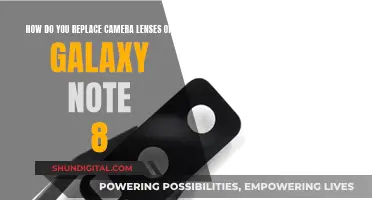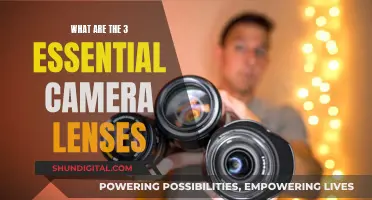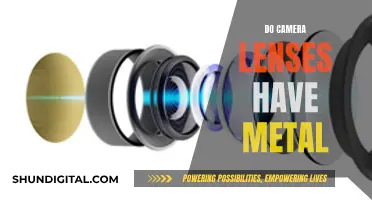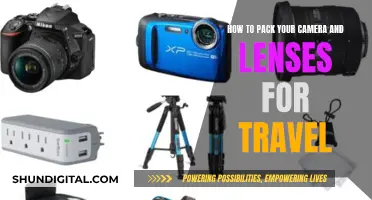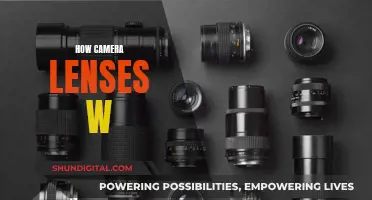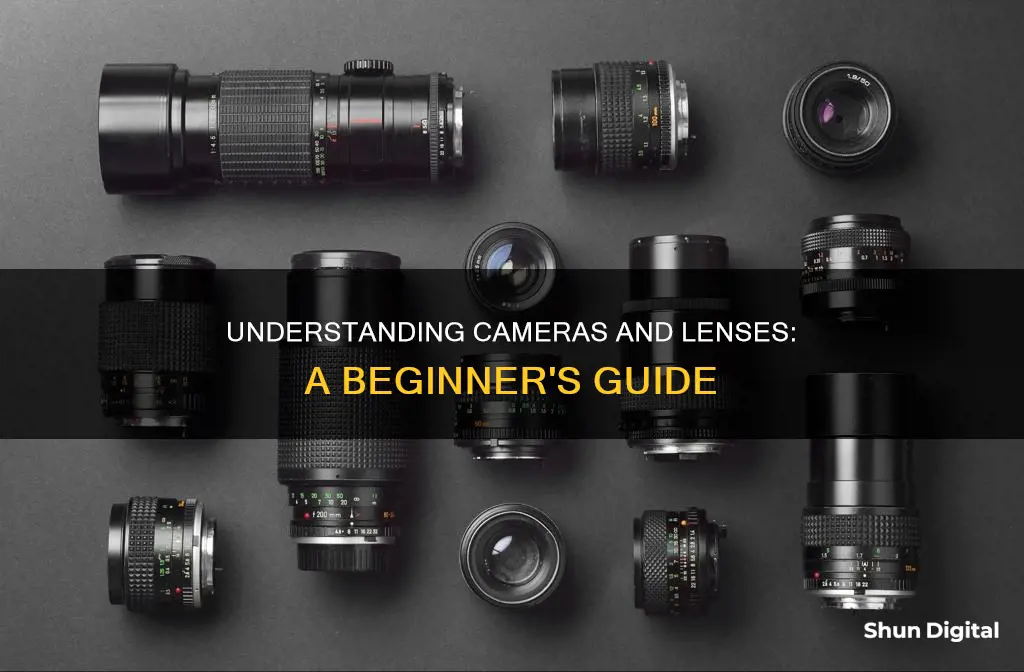
Learning about cameras and camera lenses can be daunting, but it's an essential part of taking your photography to the next level. The lens is arguably the most important piece of equipment a photographer can buy, even more important than the camera itself. While the camera body, megapixels, controls, light meter, ISO range, noise reduction, and shutter are all crucial components, the lens is what brings your vision to life by focusing light from the viewfinder into a tiny spot on the camera's sensor.
The creative use of lenses gives photography its expressive qualities, allowing photographers to shape the way they see the world. In this guide, we will explore the basics of camera lenses, including the different types of lenses, their features, and how to choose the right lens for your needs. We will also discuss the importance of focal length, aperture, and image quality, and provide tips on how to learn about and choose the best camera lenses for your photography journey.
| Characteristics | Values |
|---|---|
| Purpose | To focus light from what you see through the viewfinder into a tiny spot on the back of your film, DSLR, or mirrorless camera. |
| Importance | Arguably the most important piece of equipment a photographer can buy – even more important than the camera itself. |
| Anatomy | Filter thread, front element, lens hood thread, zoom ring, focus ring, lens name, A/M switch. |
| Terminology | Brand name, lens type, focal length (in mm), maximum aperture, other lens features/abbreviations. |
| Focal Length | Defined as the distance between the lens’ optical center and the camera’s image sensor (or film plane) when focused at infinity. |
| Aperture | Determines how much light the lens transmits to the image sensor. |
| Zoom Lenses | Have variable focal lengths and are extremely useful. |
| Wide-Angle Lenses | Generally considered anything 35mm or shorter (on a full-frame camera). |
| Normal Lenses | Produce images that very closely resemble what we see with our own eyes. |
| Telephoto Lenses | Have excellent reach for photographing distant subjects. |
| Fisheye Lenses | Specialized, wide-angle lenses that provide extremely wide images by changing straight lines into curves. |
| Macro Lenses | Used for close-up or “macro” photography. |
| Tilt-Shift Lenses | Enable you to manipulate the vanishing points and selectively focus an image. |
| Image-Stabilization Lenses | Contain small gyro stabilizer sensors and servo-actuated lens elements, which purportedly correct for camera shake. |
What You'll Learn

Camera lenses are the most important part of a camera
Camera lenses are arguably the most important part of a camera. While a camera body is important, it is often viewed as more disposable than the lens. A camera without a lens is useless to a photographer. The lens is what focuses light from what you see through the viewfinder into a tiny, typically 35mm spot on the back of your film, DSLR, or mirrorless camera. If you remove the lens from your camera, the only kind of image you can produce is white light.
A high-quality lens can help you capture great photos even with a cheap camera, while a low-quality lens can make the best camera mediocre and the resulting image quality poor. A bad lens on a good camera will still make poor images, but a good lens on a poor or average camera will most likely give the photographer good results. Lenses matter because they control which photos you can even take in the first place.
The most important specification for most lenses is their focal length – in generic terms, how far "zoomed in" the lens is. Focal length is written in millimeters. Some lenses only have a single focal length, and these are known as prime lenses. Other lenses are zoom lenses, meaning that they cover a range of focal lengths.
The other critical term in a lens name is the "f/number", which stands for the lens's maximum aperture. Aperture describes the "pupil" of your lens. Just like the pupil in our eyes, the aperture in a lens will let in more or less light. Expensive lenses often have large apertures to let in a lot of light.
Camera Lenses: Waterproof or Not?
You may want to see also

Lenses with larger maximum apertures are better in low-light settings
A larger aperture (a wide opening) will pass a lot of light, resulting in a brighter photograph. This is why a larger aperture is better in low-light settings. A smaller aperture does the opposite, making a photo darker.
The aperture of a lens is usually specified as an f-number, the ratio of focal length to effective aperture diameter (the diameter of the entrance pupil). A lower f-number denotes a greater aperture, which allows more light to reach the film or image sensor.
Lenses with apertures opening f/2.8 or wider are referred to as "fast" lenses. The maximum aperture tends to be of most interest and is always included when describing a lens. This value is also known as the lens "speed", as it affects the exposure time.
The maximum aperture of a lens is so important that it’s included in the name of the lens itself. For example, the Nikon 50mm 1:1.4G lens has a maximum aperture of f/1.4.
The Ultimate Guide to Understanding Camera Lenses Variety
You may want to see also

Prime lenses offer the highest quality photos
Prime lenses are fixed focal length lenses, meaning they cannot zoom in or out. This may seem like a limitation, but the simplicity of prime lenses brings several advantages that can lead to stunning photographs and improved photography skills.
Why Prime Lenses Offer the Highest Quality Photos
Prime lenses are widely regarded as superior for several reasons. Firstly, they offer exceptional sharpness and image quality due to their design, which includes fewer elements than zoom lenses. This simplicity results in less distortion, creating sharper and more detailed images.
Secondly, prime lenses are known for their fast apertures, often presented as f/1.4, f/1.8, or f/1.2. These large apertures allow more light to enter the camera, enhancing low-light performance and enabling a shallow depth of field. The shallow depth of field effect keeps the subject sharp while beautifully blurring the background, making it ideal for portrait photography.
Thirdly, the compactness of prime lenses makes them smaller and lighter than zoom lenses. This feature not only makes them easier to carry and handle but also contributes to faster autofocus. Their compact design and faster autofocus are particularly advantageous when capturing fast-paced events or moving subjects.
Additionally, the fixed focal length of prime lenses encourages photographers to be more intentional about composition, often resulting in more creative and engaging images.
Comparison with Zoom Lenses
While zoom lenses offer the convenience of variable focal lengths, they tend to be heavier and more complex in design. This complexity may come at the cost of image quality, as zoom lenses can exhibit more distortion and optical abnormalities.
In contrast, prime lenses provide superior sharpness, low-light performance, and image quality due to their simpler construction and larger apertures.
Technical Advantages of Prime Lenses
Prime lenses offer improved sharpness, larger apertures, faster shutter speeds, and better low-light capabilities. They also naturally minimize distortion, making them ideal for wide-angle and telephoto shots. The ability to minimize distortion is a result of their dedicated design for a specific focal length, allowing engineers to optimize their performance.
Prime Lenses for Different Photography Styles
The benefits of prime lenses make them versatile tools for various photography styles, including portraiture, landscape, architecture, street, and astrophotography. The consistent focal lengths, sharp image quality, and fast apertures of prime lenses unlock creativity, enabling photographers to produce stunning images across different genres.
Choosing the Right Prime Lens
When selecting a prime lens, it's essential to consider your camera's sensor size, whether it's a full-frame or crop sensor. The 35mm lens is a versatile standard prime lens for both full-frame and crop sensor cameras, offering a natural field of view suitable for various photography styles. The 50mm lens, also known as the "nifty fifty," is another popular choice for its affordability, versatility, and excellent low-light performance.
Lending Camera Lenses: A Unique Library Offering
You may want to see also

Wide-angle lenses are best for landscape photography
Lenses are arguably the most important piece of equipment a photographer can buy – even more important than the camera itself. This is because the lens controls which photos you can take in the first place.
Wide-angle lenses are popular with landscape photographers because they create the potential for exaggerated perspective. This is achieved by allowing the photographer to get very close to a subject. The distance between the subject and background appears to increase; the subject looms large in the frame as everything else stretches out behind it, producing a real sense of drama.
Wide-angle lenses also have an inherently large depth of field, meaning you can keep everything sharp from the immediate foreground through to the horizon. This is extremely common in landscape photography, which is why a wide-angle lens is an essential item in a landscape photographer’s kit bag.
However, using wide-angle lenses is not without its problems. Framing can be tricky, especially with ultra-wide lenses of 20mm or wider. As they have such a wide coverage, finding a coherent composition that is not too busy can be an issue.
Another issue is distortion, especially if there are buildings in the scene, as they can appear to lean at odd angles. Try to reduce this at the shooting stage by keeping the camera as level as you can, without compromising your composition.
When choosing a wide-angle lens, remember that zooms offer more flexibility when it comes to finding the ideal spot and then framing the shot precisely.
That being said, there is no one-size-fits-all approach to photography. The "best" lens will always depend on the specific landscape, location, and vision of the photographer.
Building Custom Camera Lenses: A Step-by-Step Guide
You may want to see also

Telephoto lenses are ideal for sports or wildlife photography
Lenses are arguably the most important piece of equipment a photographer can buy. The lens is what focuses light from what you see through the viewfinder into a tiny spot on the back of your camera. Without a lens, the only kind of image you can produce is white light. A high-quality lens can help you capture great photos even with a cheap camera, while a low-quality lens can make the best camera mediocre.
Telephoto lenses are typically in the range of 70mm to 400mm or even longer for outdoor field sports. The wider end of the tele zoom lets you grab sideline action photos while the telephoto end lets you zoom in on the action across the field. A telephoto lens with a focal length of 70-200mm is as versatile as it is prominent. The wider end of the lens gives you a relatively short telephoto focal length, perfect for when you don't need much reach. The telephoto side allows you to get in closer, but not too close.
For sports photography, a telephoto lens with a focal length of 300mm or 400mm can be useful, especially in large venues such as a baseball stadium or soccer field. In such venues, a 70-200mm lens might be too far away to capture impactful shots. A longer telephoto lens gives you more control over what and when you shoot, which paves the way for more unique images.
Telephoto lenses are also useful for wildlife photography, as they allow you to get close-up shots of animals from a distance, without disturbing them. The longer focal length of a telephoto lens can bring you right into the action, whether it's capturing the intensity of a basketball game or the intricate details of a bird's feathers.
In addition to their versatility, telephoto lenses also offer aesthetic advantages. The telephoto compression effect brings backgrounds closer and makes them appear larger, enhancing the aesthetic qualities of the bokeh and lifting the overall look of the image. This can help to simplify the background and make the subject stand out.
Vintage Camera Lenses: Worth the Money or Not?
You may want to see also
Frequently asked questions
The lens. The lens is what focuses light from what you see through the viewfinder into a tiny, typically 35mm spot on the back of your film, DSLR, or mirrorless camera. If you remove the lens from your camera, the only kind of image you can produce is white light.
There are two basic types of lenses: prime and zoom. Prime lenses have a fixed focal length and do not have zoom capabilities. Zoom lenses have variable focal lengths.
Lenses can be categorised into three main categories based on focal length: wide-angle, normal, and telephoto. Wide-angle lenses are generally considered anything 35mm or shorter on a full-frame camera. Normal lenses produce images that closely resemble what we see with our eyes and are typically around 50mm on a full-frame camera and 28mm on a crop sensor camera. Telephoto lenses are above 85mm on a full-frame camera and 50mm on a crop sensor camera.
Some specialty lenses include fisheye, macro, mirror, and tilt-shift lenses.


